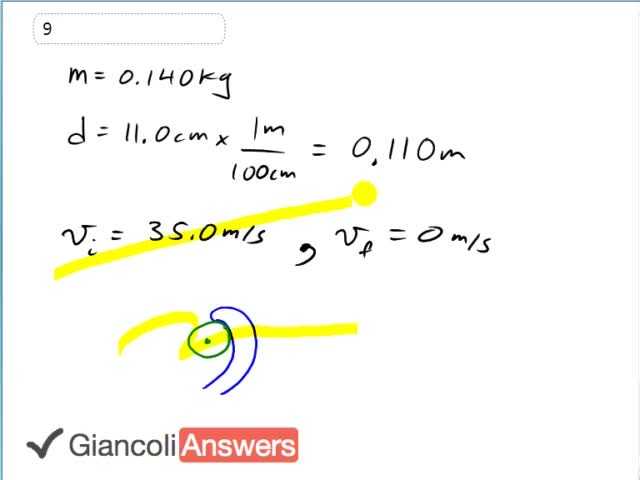

In order to watch this solution you need to have a subscription.
This baseball mitt is going to stop the baseball which has an initial speed of thrity five meters per second, and it stops it over a distance of eleven centimeters. This is how much the baseball glove recoils. So the ball might have hit the baseball glove at this point and then recoils eleven centimeters back. We'll turn that into meters in order for it to work in our formulas. That's point one one meters. And the baseball has this mass of point one four kilograms. We know that the only force that's on this ball horizontally is the force of the mitt. So that means the force of the mitt is the net force, and then we can say that it's 'ma'. So the force exerted by the mitt is going to be mass times acceleration, and we'll need to find acceleration in order to use that formula. So find 'a': We'll use 'vf' squared equals 'v' initial squared plus two 'ad', and noticing that 'vf' is zero like we said here. And we'll solve this for 'a', so we'll subtract 'vi' squared from both sides giving us two 'ad' equals 'vi' squared and then divide both sides by two 'd'. Giving us 'a' equals 'vi' squared over two 'd'. By the way I should have a minus sign there too, and a minus sign there and here. OK. We'll substitude in some numbers. So that's negative thirty five point oh meters per second squared, divided by two times point one one zero meters. Giving us an acceleration of negative five thousand five hundred and sixty eight meters per second squared. Negative meaning it's going in the negative direction and we'll assume that the initial velocity is positive to the right, and so the acceleration is to the left, making it negative. Now we can use our force formula. So force exerted by the mitt is the mass times the acceleration: zero point one four zero kilograms times negative five thousand five hundred sixty eight meters per second squared giving us an answer of negative seven hundred and eighty Newtons in the 6th Edition after we round it to three significant figures. In the 5th Edition the initial speed is different. It's forty five meters per second which we'll substitute here giving us an acceleration for the 5th Edition of negative nine thousand two hundred and five meters per second squared. And we'll substitute that here, giving us a fifth edition answer of one point two nine (negative) times ten to the three Newtons.
I understand that we are trying to find the force on the ball(hit) But the question says " what was the average force applied by the ball on the glove?" Is that just poor wording or am I not reading it right?
Thank you for your time
Thanks for the comment prologue. The wording of the question in the textbook is correct, but it's a little sneaky. You normally think of the force on the ball due to the mitt, but the mitt also experiences a "Third Law" reaction force which is the same size force applied on the mitt due to the ball. Solving for the force on the ball also solves for the magnitude of the force on the mitt since they are "action-reaction" pairs. It looks like I missed this point in the video (solving only for the force on the ball), so thank you for mentioning this. I've changed the sign of the answer at the top of this page to reflect the direction of the force on the mitt.
I understand the action reaction, Newton's third law idea but what about the equation: shouldn't the force equation be F of the mitt=(mass of the mitt)(a of the mitt)? In sum of the forces = mass times acceleration, isn't it always the sum of the forces on the object=the mass of the object times the acceleration of the object? thanks